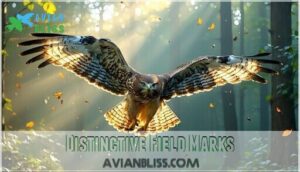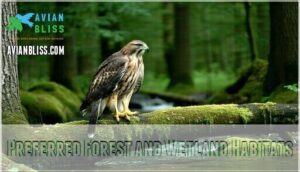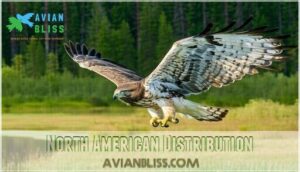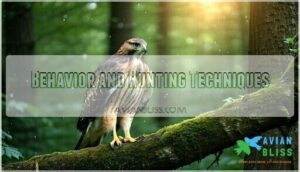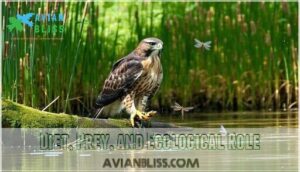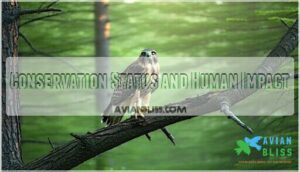This site is supported by our readers. We may earn a commission, at no cost to you, if you purchase through links.
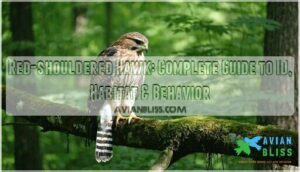
These medium-sized raptors measure 17-19 inches with wingspans reaching 42 inches.
They’re forest specialists, preferring wooded areas near water sources across eastern North America and California.
Unlike red-tailed hawks that hunt in open fields, red shouldered hawks perch-hunt from branches 15-50 feet high, ambushing frogs, small mammals, and crayfish below.
Their sharp "kee-ah" call echoes through mature forests, while translucent wing crescents create a telltale flight silhouette.
Juveniles sport streaky brown plumage that transforms into adult colors by their second year.
These adaptable predators serve as important ecosystem indicators.
Table Of Contents
- Key Takeaways
- Red-shouldered Hawk Identification and Appearance
- Habitat and Range of Red-shouldered Hawks
- Behavior and Hunting Techniques
- Diet, Prey, and Ecological Role
- Conservation Status and Human Impact
- Frequently Asked Questions (FAQs)
- What does a red shoulder Hawk look like?
- Where do red shoulder hawks live?
- How old is a red shoulder Hawk?
- What is a red-shouldered hawk?
- Are red shoulder hawks shy?
- How many red shoulder hawks are there?
- How rare is it to see a red-shouldered hawk?
- What does it mean when you keep seeing a red-shouldered hawk?
- Do Red-shouldered Hawks eat squirrels?
- Where can Red-shouldered Hawks be found?
- Conclusion
Key Takeaways
- You’ll identify red shouldered hawks by their rusty shoulder patches, banded tail with white stripes, and translucent wing crescents visible during flight
- You’ll find these medium-sized raptors in mature forests near water sources across eastern North America and California, where they’ve adapted well to suburban areas with sufficient tree cover
- You’ll observe their patient perch-hunting strategy as they sit motionless on branches 15-50 feet high, using exceptional eyesight to ambush frogs, small mammals, and crayfish below
- You’ll recognize their important ecological role as forest health indicators and population controllers, with their presence signaling healthy wetland and woodland ecosystems
Red-shouldered Hawk Identification and Appearance
Identifying a red-shouldered hawk requires careful attention to several key features that distinguish this medium-sized raptor from its relatives.
You’ll want to focus on the bird’s distinctive reddish-brown shoulder patches, banded tail, and translucent crescents near the wingtips that become visible during flight.
Look for those fiery shoulder patches and translucent wingtip crescents—nature’s stained glass windows in flight
Size and Wingspan
At 17-19 inches with a 37-42 inch wingspan, red-shouldered hawks occupy the middle ground between smaller Cooper’s hawks and larger red-tailed hawks.
Sexual dimorphism shows females averaging 15% larger than males, and regional variations exist, with California subspecies slightly smaller.
Juvenile size matches adults by fledging, and wingspan ratios help distinguish them from similar species during flight identification.
Measurement techniques focus on comparing body proportions to ensure accurate identification.
Adult and Juvenile Plumage
Adult red-shouldered hawks showcase stunning reddish-brown shoulders and barred wings, while juveniles sport streaky brown plumage that transforms through molting cycles.
Adult coloration develops fully by their second year, making age determination straightforward for experienced birders.
Juvenile molting occurs gradually, creating fascinating plumage variations. Regional differences exist, with California birds displaying more vibrant rufous tones than their eastern counterparts across North America.
Distinctive Field Marks
Beyond basic plumage patterns, you’ll notice several key field marks that make red-shouldered hawks unmistakable. Eye Color shifts from yellow in juveniles to striking orange-red in adults through Molting Patterns. Leg Feathering extends down the tarsi, unlike many similar raptors. Regional Differences create subtle Plumage Variations across their range.
To accurately identify hawks, consider using an identification resource.
Key identification features that’ll stop you in your tracks:
- Translucent crescents near wingtips glow like stained glass windows in flight
- Barred tail pattern with distinct white bands creates a zebra-like appearance
- Rusty shoulder patches blaze like autumn leaves against darker wing coverts
Comparison to Similar Hawk Species
Red-shouldered Hawks face identification challenges when compared to similar species.
Cooper’s Hawks show slimmer builds and rapid flight through dense cover, while Broad-winged Hawks display darker tail bands and smaller size.
Red-tailed Hawks lack the distinctive orange underpart barring and checkered wing pattern.
Through niche partitioning, each species occupies different hunting strategies and habitats, helping distinguish them in the field, which involves complete concepts of species identification.
Habitat and Range of Red-shouldered Hawks
You’ll find red-shouldered hawks throughout eastern North America, California, and parts of Mexico, where they prefer mature forests near water sources like swamps, streams, and wooded wetlands.
These adaptable raptors have learned to thrive in suburban areas with sufficient tree cover, though they still need access to the tall deciduous trees and water sources that support their diverse prey base.
Preferred Forest and Wetland Habitats
When searching for red-shouldered hawks, you’ll find them thriving in mature forests near water sources.
These birds require riparian forest needs like tall deciduous trees for nesting, while wetland habitat quality determines prey abundance.
Forest management impact affects their territory selection, as they prefer undisturbed canopies.
Unfortunately, habitat fragmentation effects force them into smaller patches, creating suburban adaptation challenges as they navigate human-modified landscapes.
Maintaining diverse forest structure is essential for supporting a variety of bird species.
North American Distribution
You’ll find these hawks across eastern North America, from southern New Brunswick to Florida’s Gulf Coast, with a separate Pacific population stretching from northern California to Baja.
Range expansion has pushed western birds into Oregon and Arizona recently.
Regional variations show eastern populations migrating 300-1,500 kilometers while western birds stay put.
Population density peaks where habitat fragmentation hasn’t destroyed critical wetland corridors along traditional migration routes.
In Minnesota, the species is listed as a special concern species.
Migration Patterns and Behavior
Migration triggers for Red-shouldered Hawks stem from seasonal prey availability and temperature changes.
Northern populations travel impressive migratory distances of 300-1,500 kilometers, with Wisconsin birds averaging 920 kilometers each way.
Their stopover ecology favors deciduous forests and woody wetlands for rest and refueling.
Climate impacts influence wintering behavior, with hawks avoiding high elevations and selecting warmer southern territories rich in amphibians and small mammals.
These hawks are commonly found in bottomland hardwood stands, which provide them with the necessary habitat for survival.
Adaptation to Suburban Areas
You’ll spot these adaptable raptors thriving in suburban neighborhoods where mature trees meet human development.
Their remarkable flexibility shows through successful Urban Nesting in backyard oaks and park woodlands.
Watch for these behavioral changes:
- Prey Shift from forest amphibians to suburban rodents and small birds
- Noise Tolerance allowing hunting near busy streets and playgrounds
- Human Interaction acceptance, often ignoring nearby foot traffic
However, increased Road Mortality remains their biggest suburban challenge.
Behavior and Hunting Techniques
You’ll find red-shouldered hawks are masterful hunters that rely heavily on patience and precision, spending much of their day perched motionless on branches while scanning the forest floor below.
Their hunting success depends on their exceptional eyesight and ability to remain perfectly still until the right moment to strike, which is a testament to their precision.
Perch-hunting Strategies
Red-shouldered hawks perfect their ambush tactics through strategic perch selection, choosing sturdy branches 15-50 feet above ground near water sources.
Their exceptional prey detection abilities allow them to spot movement from 100 yards away. Once locked onto a target, these patient hunters demonstrate remarkable strike accuracy and hunting efficiency, swooping down with deadly precision.
To properly identify these birds, one might find a helpful bird identification resource.
| Perch Characteristics | Detection Range | Success Rate |
|---|---|---|
| Near water edges | 50-100 yards | 65-80% |
| Forest canopy openings | 75-150 yards | 45-60% |
| Tall snags/dead trees | 100+ yards | 70-85% |
| Power lines/poles | 25-75 yards | 40-55% |
| Mixed habitat borders | 60-120 yards | 55-75% |
Flight Patterns and Territorial Displays
Soaring effortlessly above the canopy, red-shouldered hawks command their domain through dramatic aerial performances that showcase both territorial defense and courtship prowess.
Watch for these distinctive flight behaviors:
- Soaring Techniques – Wide, circular spirals on thermals with wings held flat
- Mating Displays – Spectacular sky-dancing dives and synchronized flights between pairs
- Territorial Defense – Aggressive chases and intimidation flights toward intruders
- Flight Speed – Steady 25-30 mph cruising with bursts reaching 40 mph
- Hunting Flight – Low, coursing glides through forest openings to surprise prey
Vocalizations and Calls
Beyond their aerial performances, you’ll hear red-shouldered hawks’ diverse vocal repertoire throughout their territory.
Their classic "kee-ah" call functions as both territorial defense and mate communication.
Their piercing kee-ah call echoes through the forest, marking territory with wild authority
These hawks demonstrate regional dialects, with California birds producing distinctly different acoustic communication patterns than eastern populations.
Adults teach juveniles through song learning, establishing local vocal traditions that strengthen pair bonds and territorial claims.
Recognizing these sounds requires understanding bird song structure, including rhythm and pitch.
Interactions With Other Birds
Dramatic aerial confrontations define how you’ll witness red-shouldered hawks engaging in interspecific competition and predator avoidance.
These woodland warriors face constant challenges from corvids, owls, and fellow raptors, creating dynamic nesting conflicts that shape forest hierarchies through strategic cooperative hunting alliances and complex symbiotic relationships.
You can explore options for effective hawk control if these interactions become problematic.
- Blue jays mimicking hawk calls to disrupt hunting attempts
- Crows joining forces with hawks to mob Great Horned Owls
- Multiple bird species coordinating mobbing attacks against perched hawks
- Food theft occurring between hawks and crows in overlapping territories
- Suburban hawks showing fiercer nest defense than their rural counterparts
Diet, Prey, and Ecological Role
You’ll discover that red-shouldered hawks are opportunistic predators with a surprisingly diverse menu, consuming everything from crayfish to small mammals depending on what’s available in their forest habitat.
This adaptable feeding strategy makes them essential players in maintaining the delicate balance of wetland and woodland ecosystems.
Primary Prey Species
Your red-shouldered hawk’s menu reads like nature’s buffet.
Mammal Consumption centers on small rodents—Eastern Chipmunks and Meadow Voles top the list.
Amphibian Importance can’t be overstated, with frogs forming diet staples.
Crayfish Reliance peaks in southeastern regions, while Avian Predation targets smaller songbirds.
Prey Availability dictates hunting success, with hawks consuming roughly 11% of their body weight daily—that’s 2-3 small critters per adult bird.
Seasonal Changes in Diet
You’ll notice red-shouldered hawks shift their diet substantially throughout the year, responding to Prey Availability and environmental changes.
During Breeding Season, they focus on protein-rich amphibians and reptiles.
Winter Diet becomes more mammal-heavy when cold-blooded prey is scarce, while Migratory Impact affects northern populations differently than resident birds.
Regional Variations also influence seasonal feeding patterns.
- Spring brings abundant frogs and salamanders emerging from winter dormancy
- Summer hunting peaks with active reptiles, young mammals, and nestling birds
- Winter forces hawks to rely heavily on small mammals and cached prey
Hunting Methods for Different Prey
You’ll find red-shouldered hawks employ distinct hunting methods depending on their target.
Perch hunting dominates their strategy, where they sit motionless on branches, scanning for movement below.
When targeting amphibians and reptiles, they’ll drop directly from their perch with precision.
Ground hunting becomes their go-to approach for small mammals, using low coursing flights to surprise prey.
Their hunting success varies seasonally, with prey specialization shifting as availability changes throughout the year.
Role in Ecosystem Balance
Red-shouldered hawks serve as nature’s balancing act, controlling prey populations while indicating forest ecosystem stability.
You’ll witness their impact on wetland biodiversity as these raptors regulate small mammal, amphibian, and reptile numbers.
Their presence signals healthy food web dynamics, making them essential indicator species for environmental health monitoring and conservation efforts.
They serve as sensitive barometers of environmental change.
Conservation Status and Human Impact
Red-shouldered hawks face a complex conservation landscape, with populations showing both encouraging recoveries and concerning regional declines.
You’ll find that while global numbers remain relatively stable, local threats like habitat destruction continue to challenge these forest-dwelling raptors in many areas, posing a significant risk to their well-being and highlighting the need for conservation efforts.
Population Trends and Threats
Population trends reveal troubling patterns across different regions, with contaminant exposure threatening reproductive success in up to 18% of nests.
Regional variations show eastern populations stabilizing while western birds face modest declines.
Habitat fragmentation increases predation impact, causing 21% nest failure rates.
Vehicle collisions and West Nile Virus outbreaks compound mortality pressures.
Conservation strategies must address these mounting challenges threatening long-term survival, including contaminant exposure and habitat fragmentation to ensure the species’ long-term survival.
Habitat Loss and Fragmentation
Forest Fragmentation Effects devastate red-shouldered hawk populations by breaking up their preferred mature woodlands into isolated patches.
Suburban Encroachment eliminates critical nesting sites, while Wetland Habitat Decline removes essential hunting grounds.
Riparian Zone Loss particularly impacts California populations, reducing historic range by 98% in the Central Valley.
Without Habitat Connectivity, hawks can’t access diverse prey or suitable territories, forcing them into suboptimal environments where survival becomes increasingly challenging.
This leads to reduced biodiversity overall, impacting the entire ecosystem.
Conservation Efforts and Legal Protections
Federal law shields you through the Migratory Bird Treaty Act, making harming red-shouldered hawks illegal.
State regulations reinforce these protections with closed hunting seasons.
Habitat preservation through land trusts and conservation easements creates safe havens.
Anti-poaching measures include strict permit requirements for nest removal, and reforestation initiatives restore essential woodland corridors.
Pollution mitigation targets rodenticide reduction, and community engagement programs educate residents about coexistence strategies.
Importance as an Indicator Species
When you observe red-shouldered hawks in the wild, you’re witnessing nature’s environmental detectives at work.
These raptors serve as powerful indicators of Ecosystem Health, revealing critical information about their surroundings through their presence and behavior.
Scientists monitor red-shouldered hawks to assess:
- Pollution Levels – Bioaccumulation Effects in their tissues reveal contaminant concentrations
- Forest Management success – Their nesting patterns indicate mature woodland quality
- Habitat Quality – Population density reflects wetland and riparian ecosystem condition
- Climate change impacts – Breeding timing shifts signal environmental changes
Frequently Asked Questions (FAQs)
What does a red shoulder Hawk look like?
I need to search for visual information about red-shouldered hawks since the provided knowledge doesn’t include their physical appearance.
Like a walking sunset wrapped in feathers, you’ll spot their barred reddish-peachy underparts, strongly banded tail, brownish heads, and distinctive translucent wing crescents during flight.
Where do red shoulder hawks live?
You’ll find these hawks across eastern North America, California, and northeastern Mexico, thriving in tall forests near water sources like swamps, riparian woodlands, and mixed deciduous-conifer forests.
How old is a red shoulder Hawk?
You’ll find that red-shouldered hawks typically live around 15-20 years in the wild, though some captive birds can reach their mid-twenties with proper care and nutrition.
What is a red-shouldered hawk?
You’ll recognize this medium-sized raptor by its distinctive reddish shoulder patches and banded tail. Red-shouldered hawks inhabit eastern forests, hunting small mammals, amphibians, and reptiles from perches near water sources.
Are red shoulder hawks shy?
Like shadows dancing through the forest, you’ll find these hawks aren’t particularly shy birds.
They’ve adapted well to human presence, often hunting from prominent perches and vocalizing loudly during breeding season, making them relatively easy to observe.
They are relatively easy to spot due to their loud vocalizations and prominent perches.
How many red shoulder hawks are there?
Current global population estimates range from 100,000 to 6 million red-shouldered hawks.
You’ll find their numbers generally stable across the U.S., though regional variations exist, with Canada hosting approximately 6,270 breeding pairs showing steady growth trends.
How rare is it to see a red-shouldered hawk?
You’ll likely spot these hawks if you’re exploring wooded areas near water.
With populations ranging from 100,000 to 6 million birds, they’re fairly common in suitable habitats across eastern North America and California.
Though habitat loss has reduced sightings in some regions.
What does it mean when you keep seeing a red-shouldered hawk?
Spotting hawks repeatedly, like a persistent thought that won’t fade, typically indicates you’re in their preferred habitat during active hunting periods.
You’re likely witnessing normal territorial behavior as they patrol established ranges for prey and mates.
Do Red-shouldered Hawks eat squirrels?
Yes, red-shouldered hawks do eat squirrels.
You’ll find squirrels on their diverse menu alongside small mammals, frogs, reptiles, and birds.
They’re opportunistic hunters, adapting their diet to whatever’s available in their territory, making them diverse in their eating habits.
Where can Red-shouldered Hawks be found?
You’ll discover these magnificent raptors across eastern North America, California, and northeastern Mexico.
They prefer tall forests near water sources, thriving in bottomland hardwoods, swamps, and mixed woodlands where they’ve adapted well to human-altered landscapes.
Conclusion
Understanding the red shouldered hawk transforms your forest walks into discovery adventures.
You’ll spot their rusty patches, hear their piercing calls, and witness their patient hunting techniques.
You’ll appreciate their role as woodland guardians, controlling prey populations while indicating healthy ecosystems.
Whether you’re watching adults soar with translucent wing crescents or observing juveniles develop their distinctive plumage, these remarkable raptors offer endless opportunities for wildlife observation and environmental awareness.



